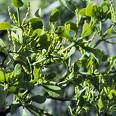Mistletoe - Best Herb for Low Blood Pressure
Viscum album Viscaceae Common throughout Europe, mistletoe is a parasitic shrub that sinks its roots into the branches if trees with a s* bark, such as ash, poplar and old apple trees. Its smooth, many-branched stems bear leathery, evergreen leaves. In May, it bears clusters if tiny, yellowish flowers. The fruit, a sticky white berry, ripens in early winter. Parts used
ConstituentsThe significant active compounds in mistletoe are viscotoxins and lectins, poisonous substances, but which, in tiny doses, are believed to boost the immune system. Medicinal usesThe capacity of mistletoe to lower blood pressure has been verified by experimental data, and seems to be due to the combined effects of a group of compounds rather than to one specific active agent. Research in Germany has shown that mistletoe has a stimulating effect on the immune system and inhibits the growth of tumours an effect attributed to its viscotoxins and lectins. This could make mistletoe useful in fighting cancer, if the toxicity of these components can be controlled. It has also been claimed that the plant can treat hardening of the arteries, but results of human clinical trials have proved disappointing. PREPARATION AND DOSAGEWhether used in a simple infusion or in any other pharmaceutical preparation, only a medical herbalist or doctor can decide if mistletoe is a safe or suitable treatment. CultivationMistletoe is a parasitic plant, only found in the wild on trees at least 15 years old. Rubbing its berries into crevices in the underside of the bark of a suitable soft-barked tree, such as apple, willow or rowan, can encourage mistletoe to grow there. CAUTIONBecause mistletoe leaves and berries contain several poisonous substances, no preparation of the plant should be taken unless under the supervision of a qualified medical herbalist or doctor. |
Ayurveda Book
This book on Ayurveda is meant for people interested to know about basics concepts of Ayurvedic healing and learn ayurveda concepts. Though there are many books Read More My SitesReal Testimonials
Connect with us |







